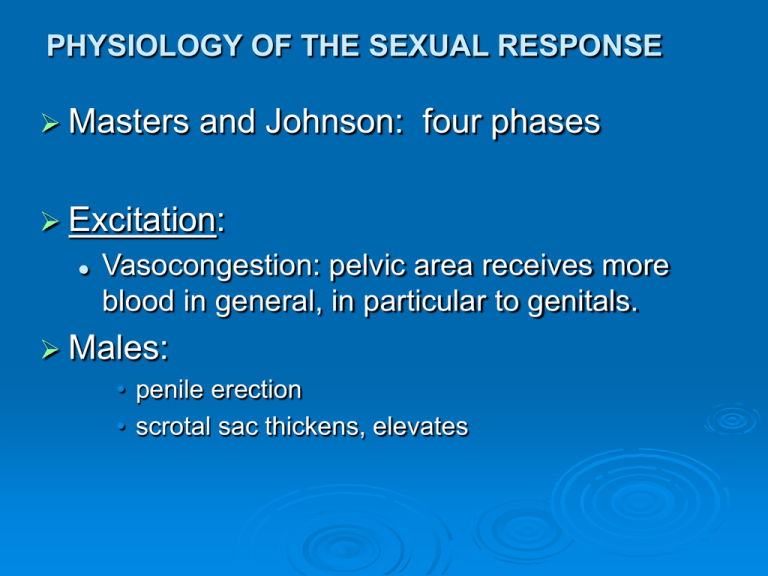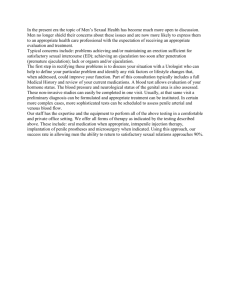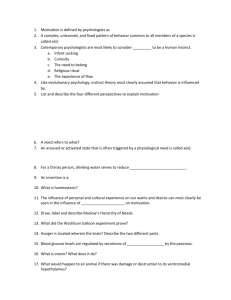
PHYSIOLOGY OF THE SEXUAL RESPONSE
Masters
and Johnson: four phases
Excitation:
Vasocongestion: pelvic area receives more
blood in general, in particular to genitals.
Males:
• penile erection
• scrotal sac thickens, elevates
PHYSIOLOGY OF THE SEXUAL RESPONSE
Excitation
(Cont’d)
Females:
•
•
•
•
•
vaginal lubrication
glans clitoris enlarges (similar to penile erection)
nipples erect (myotonia: muscle contraction)
breasts enlarge (vasocongestion
inner lips of vulva swell and open, change in colour
(darker)
• upper 2/3rds of vagina balloons
• cervix and uterus stand up: tenting effect
• angle of cervical opening more receptive to sperm
PHYSIOLOGY OF THE SEXUAL RESPONSE
Excitation
(Cont’d)
Both Sexes:
• sex flush (can happen later)
• heart rate, respiration rate gradually
increase
• generalized myotonia
PHYSIOLOGY OF THE SEXUAL RESPONSE
Plateau:
Both males and females continue
vasocongestion to max
Heart rate, respiration rate and blood
pressure continue to increase
Copious perspiration
Increased myotonia
PHYSIOLOGY OF THE SEXUAL RESPONSE
Plateau (Cont’d)
Females:
orgasmic platform:
outer third of vagina
thickens, swells:
condition sine qua
non: without it, no
orgasm
tenting complete
clitoris erect
PHYSIOLOGY OF THE SEXUAL RESPONSE
Plateau (Cont’d)
Males:
Cowper’s glands
secrete fluid through
tip of penis.
WARNING: may
contain live sperm!
scrotum even higher
and testicles bigger
PHYSIOLOGY OF THE SEXUAL RESPONSE
Orgasmic:
Males: Two stages:
• contraction of seminal
vesicles, vas and
prostate
• contraction of urethra
and penis: ejaculation
PHYSIOLOGY OF THE SEXUAL RESPONSE
Orgasmic:
Females:
• contractions of
orgasmic platform
• contractions of uterus
• several orgasms
possible if stimulation
continues
• oxytocin
PHYSIOLOGY OF THE SEXUAL RESPONSE
Orgasmic:
Both:
very high heart rate, blood
pressure and breathing
intense myotonia
PHYSIOLOGY OF THE SEXUAL RESPONSE
Health
Benefits Associated With Orgasm
General Health
• An orgasm at least once or twice per week
appears to strength the immune system’s ability to
resist flu and other viruses
Pain Relief
• Some women find that an orgasm’s release of
hormones and muscle contractions help relieve the
pain of menstrual cramps and raise pain tolerance
in general.
PHYSIOLOGY OF THE SEXUAL RESPONSE
Health
Benefits Associated With Orgasm
(Cont’d)
Lower Cancer Rate
• Men who have more than five ejaculations per
week during their 20s have a significantly lower
rate of prostate cancer later in life
Mood Enhancement
• Orgasms increase estrogen and endorphins, which
tend to improve mood and ward off depression in
women
PHYSIOLOGY OF THE SEXUAL RESPONSE
Health
Benefits Associated With Orgasm
Greater Feelings of Intimacy
• The hormone oxytocin, which may play a role in
feelings of love and intimacy, increases fivefold at
orgasm
Better Sleep
• The neurotransmitter dopamine, released during
orgasm, triggers a stress-reducing, sleep-inducing
response that may last up to two hours
PHYSIOLOGY OF THE SEXUAL RESPONSE
Emotional Changes During Orgasm:
Based on EEG, MRI and PET scans done in the
lab while subjects having an orgasm.
General emotional response:
• coded in limbic association area, especially prefrontal cortex
and cingulate gyrus.
Pleasure:
• coded in basal forebrain, especially ventral tegmental area
and its dopaminergic stimulation of the reward centres of the
septal nuclei and the nucleus accumbens.
Euphoria:
• probably by assymetric cortical activation
The proportion and intensity of each varies with each
orgasm.
So: orgasms differ
PHYSIOLOGY OF THE SEXUAL RESPONSE
Resolution:
Return to normal, muscles relax, breathing
etc. back to normal, blood back to circulation
from genitals.
Males
• refractory period
EACH
PHASE MUST BE FULLY
COMPLETED IN ORDER TO REACH
THE NEXT ONE
PHYSIOLOGY OF THE SEXUAL RESPONSE
SOME
GENDER DIFFERENCES:
Excitation: women slower:
IT
cultural expectations, socialization
pregnancy
IS VERY IMPORTANT FOR MALE
PARTNER TO MAKE SURE SHE IS
READY FOR PLATEAU STAGE
PHYSIOLOGY OF THE SEXUAL RESPONSE
SOME GENDER DIFFERENCES (cont’d)
Plateau:
Orgasm:
multiples for many women. Some women cannot go
through resolution without several orgasms,
vasocongestion persists. Thoughtful male partners go
last. Some men report more than one orgasm,
usually dry ones (no ejac.) and only one wet one.
Three types of female orgasm have been
identified by some researchers:
1.
2.
3.
without orgasmic platform women can’t have orgasm.
from clitoral stimulation, via pudendal nerve
from G-spot stimulation, via pelvic nerve
a blend of both
Resolution:
women have no refractory period
PHYSIOLOGY OF THE SEXUAL RESPONSE
SOME GENDER DIFFERENCES (cont’d)
“Pleasure centers”: (for arousal and orgasm)
Both:
• genital area
Women (and some men):
• nipples, breasts, G-spot
Men:
• prostate
Many body areas can be:
• ears, back of knees, neck, feet, abdomen, thighs, inside of
elbows, scalp
PHYSIOLOGY OF THE SEXUAL RESPONSE
SOME GENDER DIFFERENCES (cont’d)
Retrograde Ejaculation:
Two separate valves or sphincters, one to let urine
into urethra, and another to let semen into urethra.
When one is open, the other closes. In some cases,
the semen valve is closed and the urinary valve that
opens to the bladder is open. Semen flows into
bladder. No ill effects.
Is there female ejaculation? Mixed evidence.
Skene’s glands or paraurethral glands: on the urethra.
Could be supplying ejaculatory fluid.
PHYSIOLOGY OF THE SEXUAL RESPONSE
Female
Ejaculation: Fact or Fiction?
anecdotal reports available for a couple of
centuries or more
some women were said to have a copious
release of fluid that was not urine during
orgasm
research is very inconclusive, only case
histories
chemical analysis of fluid: in some studies,
found to be identical to urine, in other studies
found to be very similar to prostatic fluid
PHYSIOLOGY OF THE SEXUAL RESPONSE
Female
Ejaculation: Fact or Fiction?
the female equivalent of the prostate,
developed from the same embryonic tissue,
are the Skene’s or paraurethral glands, lining
the outside of the urethra, with some ducts
found going into the urethra
it is possible that, due to small differences
during prenatal development, some women
have hyperdeveloped Skene’s glands that
produce a fluid similar to prstatic fluid, while
many women do not have this capacity.
PHYSIOLOGY OF THE SEXUAL RESPONSE
Each phase shows age changes.
Excitation:
Men:
• fastest 16-20 years, then slow decline
Middle Age:
• very noticeable, need direct stimulation
Old Age:
• need lots of direct stimulation
Women:
• slower in teens, early 20s
• faster 30’s on
Plateau:
Men:
• capacity for longer with age
Women:
• same, but never a big problem
PHYSIOLOGY OF THE SEXUAL RESPONSE
Orgasmic:
Men:
• intensity lessens from mid- to late 20s
Middle Age:
• really noticeable
• ejaculate less volume, less forceful
Resolution:
Refractory period increases
PHYSIOLOGY OF THE SEXUAL RESPONSE
Resolution:
Men:
• longer refractory periods, 24 hrs. midlife, longer in
old age.
Women:
• no refractory periods ever.
Females
Intensity of
Response
Males
20
30
40
50
Age
60
70
80
PHYSIOLOGY OF THE SEXUAL RESPONSE
Cognitive
models:
Kaplan’s triphasic model:
• sexual desire
• vasocongestion
• muscular contraction
Walen and Roth’s model:
• emphasis on perception and evaluation, 8 steps,
necessary for the arousal cycle to be completed
NEUROPHYSIOLOGY OF THE SEXUAL RESPONSE
Neural and hormonal
involvement in sexual responses:
Parasympathetic:
• arousal
Sympathetic:
• orgasm
Spinal reflexes:
• erection and ejaculation
Erection:
• sacral cord responds to stimulation,
sends message via
parasympathetic to relax penile
arteries: more blood flows to penis.
Also, message to brain, awareness
(not if spine severed above
sacrum)
Ejaculation:
• higher in spinal cord, message to
sympathetic that causes muscle
contractions. Also, message to
brain, awareness, possibility of
control
PHYSIOLOGY OF THE SEXUAL RESPONSE
Women’s
Neural Mechanisms:
Not yet well known
Controversy surrounding G-spot and female
ejaculation.
One recent study found that sexual
sensations can be transmitted to the brain via
the vagus nerve, which is normally used for
digestive processes.
PHYSIOLOGY OF THE SEXUAL RESPONSE
Higher
Centres:
limbic system:
septal region of the
amygdala
PHYSIOLOGY OF THE SEXUAL RESPONSE
Experiments
using electrical stimulation:
Erection centers found in the limbic system,
both in monkeys and humans.
In addition to the experiment mentioned in the
text (Heath, 1972), there have been others
where male volunteers were wired and had
control of the electric charge. They would
have spent hours at it if allowed!
PHYSIOLOGY OF THE SEXUAL RESPONSE
Hormonal
Influences on Sex:
Hormone:
• substance produced by endocrine glands (internal
secretion) which affect specific organs via the
blood stream
Exocrine Gland:
• substance produced by a gland that goes to the
‘outside’, e.g., sweat, tears
Most Studied Sex Hormone:
• testosterone
• produced by testes, ovaries and adrenal glands
• important for sexual desire in both sexes
PHYSIOLOGY OF THE SEXUAL RESPONSE
Hormonal
Influences on Sex (Cont’d):
Women have 1/10th the amount but are ten
times more sensitive to it.
More testosterone in a normal person will not
increase desire or response.
Most testosterone is ‘bound’, not available in
this regard, ‘free’ testosterone is 2-5%.
Oxytocin, produced by the pituitary, important
for female orgasm.
Chemistry of Attraction
DHEA (dehydroepiandrosterone): secreted by
adrenal glands, weak androgen. Pro-hormone.
Most sex hormones and pheromones derived from
it. Same amount for males and females in
bloodstream.
Pheromones: sexual signals for both sexes.
Sensed by the vomeronasal organ.
Oxytocin: released by the pituitary when touching
or being touched by loved ones, even not in a
couple relationship. Important for attachment, also
involved in parental behaviours.
Chemistry of Attraction
PEA (phenylethylamine): called “the molecule of
love”, produce euphoria, amphetamine-like
substance produced in brain capillaries and in
catecholaminergic terminals. Low PEA levels
associated with depression (some depressions
successfully treated with PEA). Some people
become addicted to the PEA “high” and change
partners frequently to get it, it is more abundant
early in a relationship. Or believe real love has
died.
Chemistry of Attraction
Estrogen: makes women sexually attractive and
receptive. Skin, lips, hair, fatty padding (curves),
breasts, hips.
Testosterone: increases sex drive in both sexes,
too much is counterproductive.
Endorphins: produced in the brain, released in
response to touch and sex, produce positive
feelings.
Progesterone: testosterone antagonist, lowers
sex drive (in the pill as well), mild sedative,
calming effect.
Chemistry of Attraction
Serotonin: neurotransmitter. At low levels
intensifies sex drive, at high levels decreases it.
Antidepressants elevate serotonin, decrease sex
drive.
Dopamine: neurotransmitter associated with all
pleasures, increases sex drive, promotes action.
Prolactin: decreases sex drive, especially in men
(Couvade).
Chemistry of Attraction
Vasopressin: hormone produced by the pituitary,
antidiuretic (water retention), increases blood
volume and blood pressure, identified as the
“monogamy molecule”, modulates testosterone,
levels extremes of feelings, increases focus in
lovemaking.
All these substances fluctuate in a 24 hr. cycle,
also with age and environmental events.
The “high” of early love is short-lived (6-30
months). Cultural belief in passionate love
forever not realistic.
But long-term couples experience periodic reawakening of passion, (vacation, children away,
etc.)
PHYSIOLOGY OF THE SEXUAL RESPONSE
Hormonal
Influences on Sex (Cont’d):
Hormones are NOT directly responsible for
human sexual behaviour, as they are in most
animals.
Psycho-social context and culture are the
most important determinants.
In real life, people in good relationships say
that sex is better than in casual situations.
PHYSIOLOGY OF THE SEXUAL RESPONSE
Hormonal
Influences on Sex (Cont’d):
Pheromones:
In animals, substances that act as sexual
attractants, olfactory perception. Very
important for sex.
In humans, there is a vomeronasal organ,
located in the nose, that picks up
pheromones, found in sweat and genital
secretions.
Pheromones involved in menstrual synchrony.
What could be the effect of perfumes,
deodorants,etc.?
PHYSIOLOGY OF THE SEXUAL RESPONSE
Anatomy
and physiology of sex only give
us an idea of how our biological equipment
tends to work, but it does not give us an
understanding of human sexual behaviour.
Knowing car mechanics does not make
you a good driver!
In order to get this, we need to explore our
psychology, our communication styles, our
culture/s, our interpersonal skills, etc.





